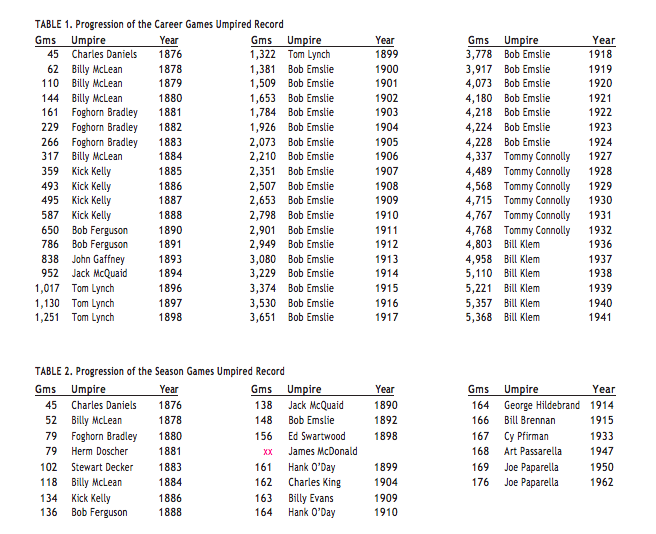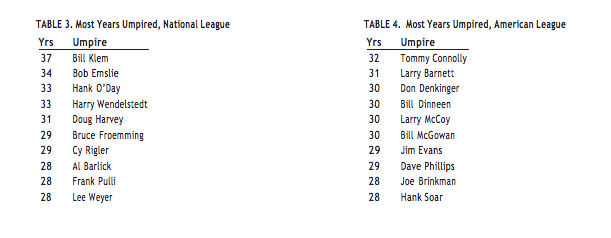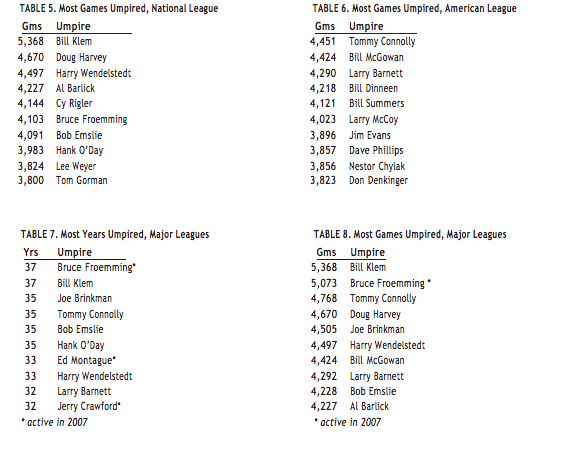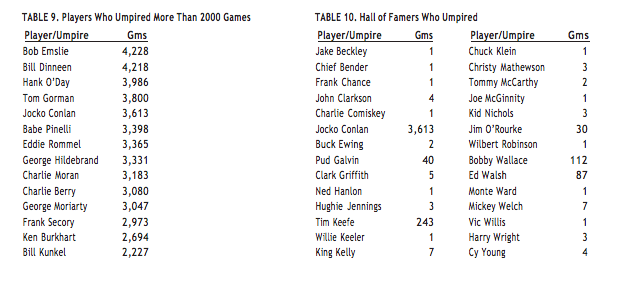A Statistical Look at the Men in Blue
This article was written by David Vincent
This article was published in 2007 Baseball Research Journal
Baseball fans love statistics. For more than a century, folks have talked about baseball numbers of all sorts around the water cooler and the hot stove, in the box seats and the bleachers, and, more recently, on call-in radio shows and the Internet. Batter numbers, pitcher numbers, and manager numbers have provoked discussions and arguments. Through all these years, however, one group of people on the field has escaped this scrutiny: umpires. This omission is primarily because umpire statistics have not been available—until now. Recently, umpire assignments in all games since the start of the National League in 1876 have been compiled by a small group of SABR and Retrosheet researchers.1
In this article we will examine the progression of the career and single-season games worked records. We will talk about some of the prominent umpires through major league history and how they fit into the sweep of history related to arbiters. Other aspects of the umpire world, including vacation substitutes and the size of crews, will be examined. All numbers quoted are valid through October 2, 2007. Let’s get started!
In the National Association, umpire assignments were haphazard at best. The home team chose the arbiter from a list submitted by the visiting squad. However, many times the selected official was merely someone in the crowd for that day’s ball game. Many NA umpires worked only one game in their careers. The situation gradually improved once the National League was formed. All career and single-season numbers in this article will ignore the National Association. William H. “Billy” McLean, a veteran National Association umpire, worked the first game in National League history on April 22, 1876, between the Boston Red Caps and the Athletics at Philadelphia’s Jefferson Street Grounds. McLean would umpire 345 contests in the National League and American Association through August 22, 1890. Charles Daniels worked the most games in the initial season of the senior circuit with 45. However, McLean claimed the career record for most games umpired in the majors in 1878, lost it to George H. “Foghorn” Bradley three years later and reclaimed it in 1884.
Table 1 (see below) shows the progression of the career record for games umpired. A number of other men held the record in the 19th century until Thomas J. “Tom” Lynch, who made his debut on April 20, 1888, became the first arbiter to work 1,000 games on September 7, 1896, in the first game of a doubleheader at Worcester. After Lynch retired as an umpire, he worked in the National League office for a time and was the league president from 1910 through 1913. John Heydler, who umpired 83 games in the 1890s, also served as NL president.
Robert D. “Bob” Emslie, an American Association player in the 1880s, began umpiring in the Association in 1890. He started the 1891 season in the Western Association, but after the league disbanded, he joined the National League staff, working his first game there on August 19, 1891. Emslie passed Lynch’s career record in 1900 and became the first arbiter to work 2,000 games on July 11, 1905, when he worked the first game of a series between the Chicago Cubs and the New York Giants at the Polo Grounds. Emslie reached the 3,000 games umpired mark on July 1, 1913, and then worked his 4,000th game on July 14, 1920. Both milestone games were played in Chicago. After the 1922 season, the native of Guelph, Ontario, was named the chief of the National League umpiring staff. In 1923 and 1924, Emslie worked a few games, bringing his career total to 4,228. Bob Emslie held the career record for 27 years until passed by an Englishman who never played baseball.
Thomas H. “Tommy” Connolly, who was born in Manchester, England, on December 31, 1870, moved with his family to Natick, Massachusetts, while still a young man. National League umpire Timothy C. “Tim” Hurst helped Connolly secure his first professional umpiring job in the New England League in 1894, and after four years in that circuit, the National League hired Connolly in 1898. He worked over 300 games in the senior circuit through mid-May 1900 but was out most of the rest of the season. Connolly was hired by the American League for its first season and worked the first game in league history, played in Chicago on April 24, 1901. Connolly worked 4,451 games in the American League by the time he retired after a game on July 31, 1932, the only game he umpired that season. He still holds the American League record for most years (32) and games umpired. Connolly passed Emslie’s major league career record on May 31, 1927, and finished with a major league total of 4,768 games when he retired. Connolly served as the American League’s umpire in chief from 1931 through 1953.
Rochester native William J. “Bill” Klem umpired his first National League game on April 14, 1905, on Opening Day in Cincinnati after three years in the minor leagues. “The Old Arbitrator” worked steadily until he retired after the 1940 season, rarely missing a game. In 1941, as the newly named chief of National League umpires, he worked 11 games on the base paths while the league experimented with a four-man crew. He finished with 5,368 games umpired in 37 seasons, both career records, and his game total is unlikely to be topped due to the way umpires are assigned in the 21st century. Klem remained the league’s umpire supervisor until his death in 1951. He and Tommy Connolly were elected to the Hall of Fame in 1953 as the first umpires so named.
The single-season record for most games umpired gradually increased from Charles Daniels’ 45 in 1876 but now has remained the same since 1962. Many of the same names held the season record as the career record in the first few years of the National League, as shown in Table 2. Stewart Decker was the first arbiter to work 100 games in one season when he umpired 102 contests in the 1883 National League. He worked back-to-back 100-game seasons with 111 in 1884 but saw his record fall to Bill McLean, who umpired 118 games in 1884. In just a few years, umpires pushed the record past a few milestones. John O. “Kick” Kelly was the first to top 130 games in a season with 134 in 1886 and Bob Emslie worked 148 in 1892. Both Ed Swartwood and James McDonald umpired 156 games in 1898 and Hank O’Day was the first to work a 160-game season when he umpired 161 contests in 1899.
Henry F. “Hank” O’Day, who played in the majors from 1884 through 1890, worked as a substitute arbiter seven times before he retired as an active player. Players frequently were employed as umpires when the assigned umpires were not available due to travel problems, illness or other issues. O’Day started working as a regular National League umpire in 1897 after two years in the Western League. He umpired in the senior circuit through the 1927 season with two years out to work another job. In 1912, O’Day managed the Cincinnati Reds and then returned to umpiring the following season. In 1914, he again took a managing job, this time with the Cubs in his native Chicago. At the start of the 1915 season, O’Day was out of baseball, but the National League rehired him during the season and he resumed umpiring on August 8 in Chicago. After umpiring his last game on October 2, 1927, O’Day finished with 3,986 major league contests. He then acted as an umpire scout for the National League through 1930.
One other longtime umpire also played and managed in the major leagues. George J. Moriarty played briefly in the National League for the Chicago Cubs in 1903 and 1904. He then played in the American League from 1906 through 1916. He became an umpire in the American League in 1917 and worked through the 1940 season except for 1927-28, when he managed the Tigers. Moriarty umpired 3,047 American League games in his career. No other person who played and managed in the majors umpired 1,000 major league games.
The single-season record inched up over the next 50 years until American League umpire Joe Paparella worked 169 games during the 154-game 1950 season. Paparella worked 31 doubleheaders that year, including five instances of double dips on consecutive days. For three days starting on September 25, Paparella worked doubleheaders as the season wound down. His partners also worked hard that season, with Cal Hubbard umpiring 167 games and Eddie Rommel umpiring 165. The 41-year-old Paparella was in his fifth season in the junior circuit and worked a more reasonable schedule before and after that incredible 1950 season. However, in 1962, Paparella broke his own season record by working an absurd total of 176 games. He umpired in 30 doubleheaders that summer, although none came on back-to-back days during the 162-game season. Two of Paparella’s partners worked record-breaking totals that year, as Hank Soar umpired 175 and John Rice 174 contests.
Three times since 1962 a crew has approached the number of games worked by the 1962 umpires. In 1969, Nestor Chylak, Jerry Neudecker, and Jake O’Donnell each umpired 170 games. Two years later, Russ Goetz worked 173 contests, while Neudecker and Dave Phillips each umpired 172 games. In 1975, Goetz, Bill Deegan, and George Maloney all worked 171 games. All these umpires worked for the American League. Only two National League arbiters have ever umpired 170 games in one season: Dusty Boggess and Stan Landes in 1962, who both worked exactly 170 contests.
After the 1999 labor problems between the umpires and Major League Baseball, MLB united the two league umpire staffs into one. Records for years of service and games umpired for each league through 1999 are listed in Tables 3 through 6. It is interesting to note that Bruce Froemming’s 29 years in the National League (1971-99) rank sixth all-time, but that is not his entire career, since he continued to work on the combined major league staff in 2000. Larry Barnett would have tied Tommy Connolly for most years worked in the American League were it not for the unification of the umpires in 2000. Joe Brinkman recorded seven years and Dave Phillips two years as part of the major league staff in the 21st century in addition to their time in the American League.
For major league service time (all leagues combined), Bill Klem and Bruce Froemming top the list. Table 7 shows most years in the majors as an umpire, while Table 8 shows total career games. Through 2007, Klem and Froemming are tied with 37 years apiece umpiring in the big leagues, and they are also the only arbiters with at least 5,000 games worked in the majors. There are 17 men who have umpired at least 4,000 contests and 74 with 3,000 games worked. Under the new contract between Major League Baseball and the umpires put in place after 1999, staff umpires now get four weeks’ vacation during the season. Three of these weeks are as a crew, while the fourth week is an individual vacation. The result of this is that Major League Baseball selects about 20 minor league umpires who fill in for staff arbiters who are on vacation, ill, or otherwise not available to work a game. In 2007, there are 17 four-man crews, which allows two crews to be off each week and still have the required number of crews to work all big league games.2 It is common for a crew to be working with one member of the crew absent and replaced by a minor league arbiter.
Another negotiated point in the contract is that the plate umpire in one game of a doubleheader usually only works that one game. A minor league umpire is assigned to the crew for the day and works first base in the first game and third base in the second, in both cases replacing the plate umpire from the other contest.
Since 2000, staff umpires work approximately 135 games in a season. Minor league umpires work a wide range of game totals while filling in for the absent arbiter. Some have worked a rather high total in some seasons. Dan Iassogna, now a member of the staff, umpired in 159 games during the 2000 season and 150 the next year. Lance Barksdale, also now a staff umpire, worked 156 games in 2001 and 151 the following year. Mike Vanvleet and Jim Wolf also worked at least 150 games in one season since 2000. Chris Guccione, who made his big league debut on April 15, 2000, has worked more than 150 in two seasons and at least 125 in six seasons. Guccione has umpired 992 major league games since his debut without being a member of the major league staff, more than any other minor league umpire.
Many former players have become umpires through the years. Of these arbiters, 14 worked at least 2,000 games in the majors. Leading the list (shown in Table 9) is Bob Emslie, who held the career games umpired record for 27 years. Bill Dinneen umpired more games than any other player who umpired his first game as an active player. Dinneen holds the distinction of having thrown a no-hitter while pitching and then calling one from behind the plate as an umpire. Tom Gorman, father of umpire Brian Gorman, worked 3,800 games as a big league umpire and was the last former player to umpire in the National League on September 4, 1977.
However, the real king of players who umpired is John “Jocko” Conlan. Jocko worked two American League games while still a player with the Chicago White Sox in 1935. He became a National League arbiter in 1941 and worked through 1965 for a major league total of 3,613 games. He was elected to the Hall of Fame in 1974 for meritorious service as an umpire. Other notable players who turned to umpiring later in life include Ralph A. “Babe” Pinelli, who was the plate umpire for Don Larsen’s perfect game in the 1956 World Series, Pinelli’s last game as an umpire. The last player-turnedumpire to work a major league game was William G. “Bill” Kunkel, whose son, Jeff, played in the majors. Kunkel umpired his last game on August 28, 1984.
Twenty-eight Hall of Famers have umpired at least one game in the big leagues. Some of the notables on the list include Cy Young, Chuck Klein, Frank Chance, and Willie Keeler. Table 10 contains the complete list.
The number of umpires working a game has increased through the years. For most of the 19th century, one person umpired each game. The Players League in 1890 employed two umpires for each game during its one season of existence. The National League used a two-man crew in 1898 and 1899 but reverted back to the single arbiter system in 1900. Both the National and American Leagues used two-man crews starting in 1909 and gradually moved to three-man crews in the mid-1920s, with some exceptions for more experienced umpires, who continued to work with just one partner. The integration to three-umpire crews was completed by the early 1930s. The four-umpire crew gradually became the norm in the early 1950s. The Senior Circuit used a five-man crew for at least part of the 1957, 1961 and 1968 seasons. In 1957, Ed Sudol made his debut on June 29 and worked as the fifth umpire for much of August and September. In both 1961 and 1968, the league prepared for the expansion that took place in 1962 and 1969 by training an extra arbiter.
As we move into the future, it is exciting to have statistics for games umpired. This data can be the start of many studies on umpiring and umpires.
DAVID VINCENT is the official scorer for Major League Baseball in Washington, DC.
Notes
- There are eight games during the 1979 umpire strike for which we do not know the names of the substitute Assignments for the National Association are only partially compiled. Statistics and game logs for all umpires are available at www.retrosheet.org.
- Since there are 30 major league teams, there can be no more than 15 sites with games on any given day.
TABLES
Click images to enlarge:






